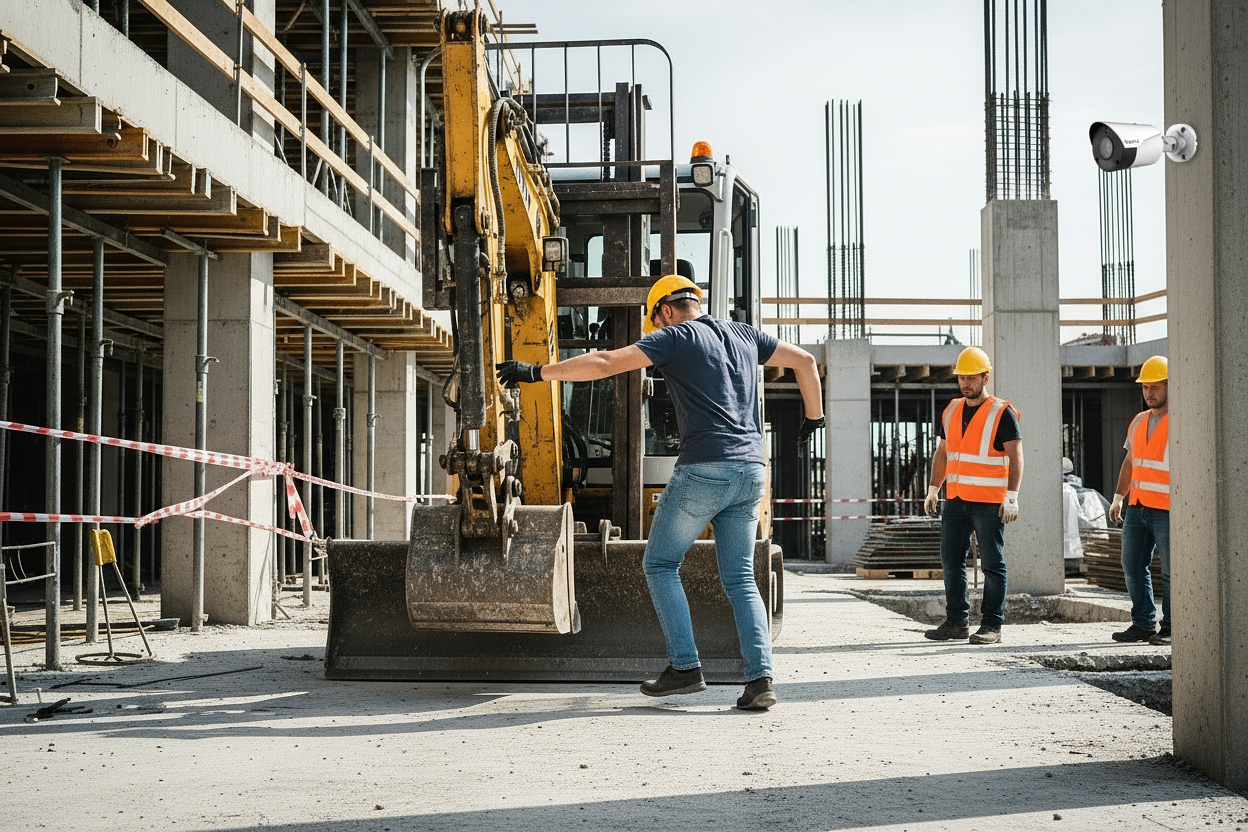Construction keeps the world moving, but it’s a tough business—one where the wrong step, a skipped check, or a missed protocol can change lives in a moment. In 2023 alone, the U.S. construction industry saw 1,075 worker fatalities, accounting for more than 1 in every 5 workplace deaths nationwide. Being struck by equipment, electrocutions, and caught-in/between incidents—known as the "Fatal Four"—were responsible for nearly 60% of those deaths (Source: U.S. Bureau of Labor Statistics). And for every fatality, there are thousands more non-fatal injuries, with serious incidents costing companies $43,000 each on average (Source: National Safety Council). What’s striking is that the likelihood of many of these injuries can be substantially reduced. Whether it’s a run-in with heavy equipment, an unnoticed electrical hazard, or a trench collapse, root causes like poor oversight, missed signals, or skipped protocols are at play. That’s why leading construction firms are doubling down on effective safety programs—combining proven On-the-Ground practices with advanced tech like AI-powered video monitoring that can assist in identifying risks before they escalate. In this guide, we’ll break down four of the most common injuries on construction sites and, most importantly, how to mitigate them. We’ll show how a strong safety culture, established mitigation protocols, and the right technology—like video intelligence—work together to keep workers safer and every job on track.
The top 4 common injuries in construction (and how video intelligence helps)
Every construction site is unique, but the leading causes of serious injury are remarkably consistent. Here are the four types of prevalent injuries that every safety leader should have on their radar—with actionable tips and the role video intelligence plays in mitigating them.
1. Struck-by Incidents (Vehicles, Tools, or Equipment)
Scenario
A laborer crosses a busy work zone, unaware that a forklift is reversing with a pallet of bricks. The operator’s view is blocked. In seconds, the worker is struck, suffering multiple fractures.
Root Causes & Impact
Struck-by incidents accounted for 8% of construction fatalities in 2023, with highway work zones seeing 63% of such deaths from vehicle strikes (Source: CPWR). Causes include dropping tools from above, moving vehicles, and flying debris. The risks rise dramatically in high-traffic zones with poor visibility and insufficient barricading. Additionally, 60% of equipment operators do not check their blind spots before moving (Source: NIOSH).
Injuries often involve multiple body parts and can lead to fractures, amputations, or worse. Each event disrupts site operations and can have lifelong consequences for the worker.
How video intelligence helps
Today's video systems with AI analytics can detect unauthorized personnel in equipment zones, alert supervisors when people enter restricted vehicle zones, and flag non-compliance with high-visibility PPE protocols. These systems also offer footage to retrain teams on safe movement patterns and incident root causes.
2. Electrocutions
Scenario
An electrician works near an exposed temporary power line. A supervisor walks by but doesn’t notice the missing lockout tag. A crane’s boom, unnoticed by the ground crew, swings into the line. The resulting electrocution is critical.
Root Causes & Impact
Electrocutions made up 8% of construction fatalities in 2023 (Source: U.S. Bureau of Labor Statistics). Most are traced to contact with live wires, faulty equipment, or failure to enforce lockout/tagout (LOTO) procedures. Wet conditions and metal ladders add to the risk.
Electrocution injuries are serious—burns, cardiac trauma, and fatalities are common. Each incident has far-reaching effects, with some resulting in lifelong disability and considerable operational disruption.
How video intelligence helps
AI cameras can track critical zones and send alerts if unauthorized personnel enter restricted areas during electrical work. Video records enable safety teams to spot recurring LOTO non-compliance and address training gaps on the spot.
3. Caught-In/Between (Trenches, Machinery)
Scenario
A crew is laying pipe in a trench. The trench box is 10 feet away—removed to allow equipment access. A supervisor leaves to get more materials. The unstable soil collapses, trapping a worker.
Root Causes & Impact
Caught-in/between incidents caused 5.4% of construction worker fatalities in 2023 (Source: U.S. Bureau of Labor Statistics). They stem from trench collapses, machinery entanglement, and unguarded moving parts. Common causes include missing trench shields, ignored soil stability checks, and tight workspaces.
These incidents are often critical, leading to crushing injuries, amputations, or death. They frequently result in major OSHA citations and major costs due to their severity and the operational disruption they cause.
How video intelligence helps
Video analytics can observe trench activity, alerting supervisors when equipment or unauthorized personnel enter “no-go” zones. Continuous visual records also support enforcement of machinery guard protocols and aid in pinpointing exactly when and how unsafe acts occur.
4. Overexertion and Musculoskeletal Injuries
Scenario
A concrete finisher spends hours bending, lifting, and moving heavy formwork to stay ahead of schedule. Short on staff, he skips his break. Days later, he is sidelined with a major back injury.
Root Causes & Impact
Overexertion injuries—especially to the back—are widespread and costly. Factors include repetitive heavy lifting, poor posture, and skipped breaks. Work conditions—like assembling cement structures—often require prolonged bending and awkward positions.
While not always fatal, these injuries cause lost time, higher insurance costs, and long-term health issues for workers.
How video intelligence helps
AI cameras can assist supervisors in monitoring for activity in work zones during scheduled rest periods. Supervisors can use this data to identify patterns of skipped breaks and adjust workflows to reduce the risk of burnout.
Hurdles and impact of the injuries
Each injury type presents distinct obstacles and impacts on a jobsite, where data and technology can make a difference:
How technology strengthens injury mitigation in construction
Effective construction safety involves more than hard hats and hazard signs. Here’s how video intelligence fits into the proactive strategy for each injury type:
Struck-by Incidents
Safety hurdle
Forklifts, dump trucks, and tower cranes all move with limited visibility. Pedestrians and vehicles share the same space, and even the best-trained operators can’t see everything.
Tech Solution Video intelligence can track people and vehicles, sending prompt alerts when someone enters a high-risk zone or an operator’s blind spot. AI can also monitor high-traffic areas for missing barriers and flag non-compliance with high-visibility PPE. Reviewing event footage helps safety teams coach both operators and crews on safer practices.
Electrocutions
Safety hurdle
LOTO tags get skipped, temporary lines are exposed, and a moment of inattention can lead to a serious incident.
Tech Solution AI can be trained to detect when workers enter unauthorized electrical enclosures, even in off-hours. If a risk is detected, supervisors get timely notifications—allowing for rapid intervention and improved compliance documentation for OSHA.
Caught-In/Between
Safety hurdle
Trench boxes are sometimes removed “just for a minute.” Machine guards are bypassed for quick fixes. Workers enter tight spaces to retrieve tools without thinking twice.
Tech Solution Video analytics track activity to ensure unauthorized personnel stay out of danger zones. AI can also monitor for missing machine guards or unsafe equipment operation. Reviewing video after close calls helps identify and address unsafe shortcuts before they lead to an incident.
Overexertion and Musculoskeletal Injuries
Safety hurdle
Muscle strains, repetitive lifting, and skipped breaks are frequent—especially when teams are short-handed or under deadline pressure.
Tech Solution AI-powered video can observe work zones to help verify teams are taking scheduled breaks, a key factor in mitigating overexertion. By tracking activity levels and worker presence over time, supervisors can identify teams or individuals who consistently skip rest periods and intervene to adjust workloads or schedules. This data offers clear evidence to leadership for resource adjustments.
Practical implementation of safety technology
Bringing AI-powered video intelligence onto a construction site doesn’t mean starting from scratch. Here’s how to make it work for your safety program:
- Integrate with what you have: Advanced video intelligence platforms, like Spot AI, work with most existing camera systems—no need for a full rip-and-replace.
- Support, not replace, your team: Technology is a second set of eyes, not a substitute for boots-on-the-ground safety walks and toolbox talks. Use AI alerts to empower supervisors, not overwhelm them.
- Customize for your risks: Every jobsite is different. Focus cameras and analytics on your highest-risk zones—scaffolds, trenches, equipment crossings, and electrical panels.
- Demonstrate value across the team: Frame video intelligence as a tool that delivers measurable data to make everyone’s job safer and more efficient—from the apprentice to the project leadership.
- Choose solutions that scale: Look for platforms that are easy to deploy, simple to search, and deliver actionable data—not just endless hours of footage.
The best technology works quietly in the background, catching what people might miss, and helping your team do their jobs better.
Drive safer outcomes on every construction site
Ready to reduce frequent injuries and contribute to making your site a place where everyone goes home safe? Spot AI partners with construction leaders to build smarter, safer jobsites—combining real-world know-how with powerful, easy-to-use technology. Our goal: empower your team, reduce incidents, and keep projects moving.
Book a safety consultation to see how you can make video intelligence a seamless part of your safety program: Book a safety consultation.
Frequently asked questions
What’s the best way to reduce struck-by incidents with vehicles or equipment?
Separate workers from moving vehicles using barricades and clear walkways. Use high-visibility PPE and, for added protection, deploy AI-powered cameras that detect when someone enters a vehicle’s blind spot or a restricted area, sending timely alerts to address the situation (Source: CPWR).
How to improve lockout/tagout (LOTO) compliance for electrical safety?
Train your team on LOTO protocols and use checklists before work begins. Video AI analytics can flag unauthorized attempts to access energized equipment, offering an extra layer of oversight and documentation for compliance (Source: OSHA).
How to use video intelligence to mitigate caught-in/between injuries?
Position cameras to observe trenches, excavation sites, and machinery. AI can alert supervisors if anyone enters a hazardous zone. This supports your team's vigilance and helps maintain compliance with site safety rules.
What ergonomic risks can video intelligence help address?
Video AI can assist supervisors in verifying that workers take scheduled breaks by observing activity in work zones during designated rest times. This data helps supervisors identify patterns of overwork and adjust schedules or staffing to reduce the risk of burnout and strain-related injuries.
How to integrate AI cameras into my existing construction safety program?
Choose a video intelligence platform that works with your current cameras and workflows. Start by focusing coverage on your highest-risk areas, and use alerts to supplement—not replace—your in-person safety processes. Engage your team early and use video insights to drive continuous improvement.
How to use video AI to improve PPE compliance across my site?
Deploy AI cameras in high-risk zones to scan for required Personal Protective Equipment, such as hard hats and high-visibility vests. The system can send a timely alert to a supervisor when non-compliance is detected, creating an opportunity for on-the-spot coaching. This provides your team with a digital assistant to help enforce safety policies consistently.
About the author
Joshua Foster is an IT Systems Engineer at Spot AI, where he focuses on designing and securing scalable enterprise networks, managing cloud-integrated infrastructure, and automating system workflows to enhance operational efficiency. He is passionate about cross-functional collaboration and takes pride in delivering robust technical solutions that empower both the Spot AI team and its customers.

























.png)
.png)
.png)